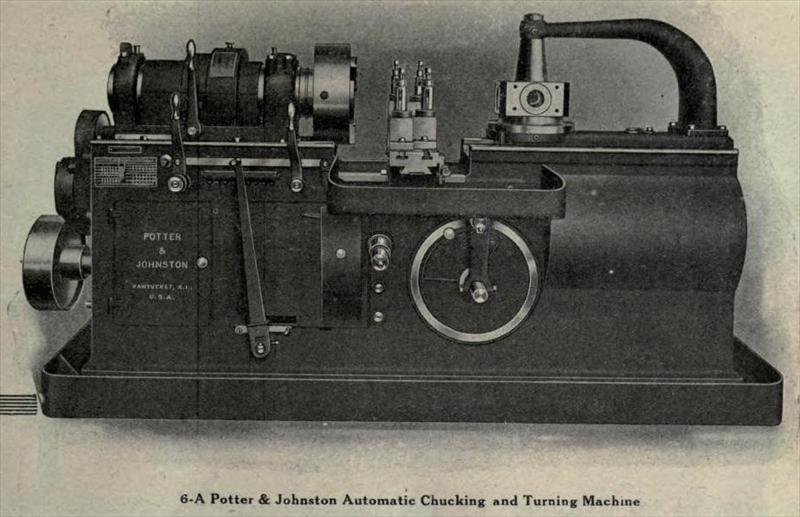Manufacturers Index - Potter & Johnston Machine Co.
Potter & Johnston Machine Co.
Pawtucket, RI, U.S.A.
Manufacturer Class:
Metal Working Machinery
Last Modified: Aug 1 2018 4:41PM by Jeff_Joslin
If you have information to add to this entry, please
contact the Site Historian.
|
The Potter & Johnston Machine Co. was founded in 1898 by just-retired industrialist James C. Potter and a former machine designer for Pratt & Whitney, John Johnston. The company survived into the early 1950s, by which time it was a subsidiary of the Pratt & Whitney Co.

Detail of ad from 1916-12-21 Canadian Machinery
Information Sources
- A trademarks website indicates that the "Potter & Johnston" trademark was owned by the Potter and Johson [sic] Machine Co. of Pawtucket, RI, and was first used 1898-12-15, first used in commerce 1901-04-24, filed 1947-08-08, and expired 1992-11-03.
- The American Museum of Natural History's page on its holdings for Potter & Johnston Machine Co. says that the name was in use since 1898.
- 1900-02-05 American Machinist has an illustrated article on Potter & Johnston's shops.
- January 1907 Proceedings of the American Society of Mechanical Engineers.
JAMES C. POTTER
James C. Potter, Pres. Potter & Johnston Machine Co., Pawtucket, R. I. Born Glasgow, Scotland, 1855. Machinist's Institute, Glasgow. Apprentice, Glasgow. H. J. H. King & Co., 1869-1874, and Anchor Line Steam Ships Co. Drawing-room, designing with King & Co. and with Anchor Line Steam Ships Co. for 25 years. Manager and President of Potter & Atherton Machine Co.; Howard & Bulloch, and with Potter & Johnston altogether a period of 26 years. Thirty-six years practical experience as machinist, draughtsman, experimenter, inventor and manager. Present position, President and General Manager of the Potter & Johnston Machine Co., engaged in manufacturing automatic machine tools.
References: Frank Mossberg, Henry D. Sharpe, William A. Viall, Richard II. Rice, E. P. Bullard.
- 1908 book, Representative Men and Old Families of Rhode Island.
JAMES CHARLES POTTER, organizer and principal owner of the Potter & Johnston Company, of Pawtucket, and one of the city's prominent business men, has attained his present influential position as the culmination of a career of uninterrupted advancement. A man of unusual natural endowments, combined with a fine technical training, Mr. Potter has always displayed an aptitude for practical undertakings which has made a success of every enterprise with which he has been connected. This is perhaps an heritage from his Scotch ancestors, as Mr. Potter is not only a descendant of that race, but was himself born in Scotland May 2, 1855.
...James C> Potter received his earlier education training in the chools of his native land, and then, when old enough to choose his path for life, he entered the Mechanics' Institute in Glasgow, to fit himself for an engineer. His preparation completed, he secured his first osition with the firm of H. J. H. King & Company, experimental engineers of Glasgow. After working for them some time as an experimental and mechanical engineer, he left that firm to enter the engineering department of the Anchor Line Steamship Company, in Glasgow, and from there went to the Vale of Clyde Engineering Works, of Glasgow, where he had charge of one of the departments. In 1874... Mr. Potter joined his father in Lowell, Mass., where he took charge of the designing and construction work, and later became manager of the Whitehead and Atherton Machine Company. This association continued for thirteen years.
In 1887 Mr. Potter left Lowell for Pawtucket, R. I., establishing in the latter city the Potter & Atherton Machine Company. When the factory opened, twenty men were employed, but in six years there were 250 names on the payroll, six years later, in 1893, he organized the Howard & Bullough American Machine Company, Ltd., the largest establishment in the vicinity of Pawtucket engaged in manufacturing machinery. The huge factories are situated on the north side of the railroad, a short distance from the east bank of the Blackstone river, overlooking the city of Central Falls. About 1,250 men are employed, and all kinds of cotton machinery are made. Mr. Potter was made president of the company and continued to direct its operation for the first five years of its existence, but in 1898 he sold out his interest, intending then to retire from active business. Six months later, however, he had returned to the world of action and established the Potter & Johnston Machine Company, of Pawtucket, in which company he is the principal owner.
Mr. Potter personally superintended the construction of the plant, which is situated on Newport avenue, and is thoroughly equipped to the last detail. The company has a capital stock of $400,000, and employs about 360 hands, and is especially fitted for the manufacture of labor-saving machine tools, namely, automatic chucking and turning machines, for manufacturing the component parts of all kinds of machinery, including automobiles, ordnance work, electrical, agricultural and textile machinery, stationary, marine and locomotive engines, sewing machines, etc. This plant is in every respect, both inside and out, one of the most up-to-date and substantially built manufacturing establishments in the United States, and the machinery turned out is of the highest standard, and can be found in operation in the leading manufacturing centers of the world. Each month a large number of machines can be seen in the course of erection for shipment to England, Scotland, France, Italy, Germany, Austria, Sweden, Japan and Australia. This is a close corporation. The officers are: James C. Potter, president and general manager; William Wallace Potter, vice-president; John Johnston, secretary and treasurer...
- 1908 Rhode Island Business Directory lists "Potter & Johnston Machine Co. Org. 1899. Capital $400,000. James C. Potter Pres, John Johnson Treas. Machine tools."
- American Planer, Shaper and Slotter Builders: 1830-1910 by Kenneth L. Cope, 2002 page 146
- American Lathe Builders: 1810-1910 by Kenneth L. Cope, 2001 page 125
|